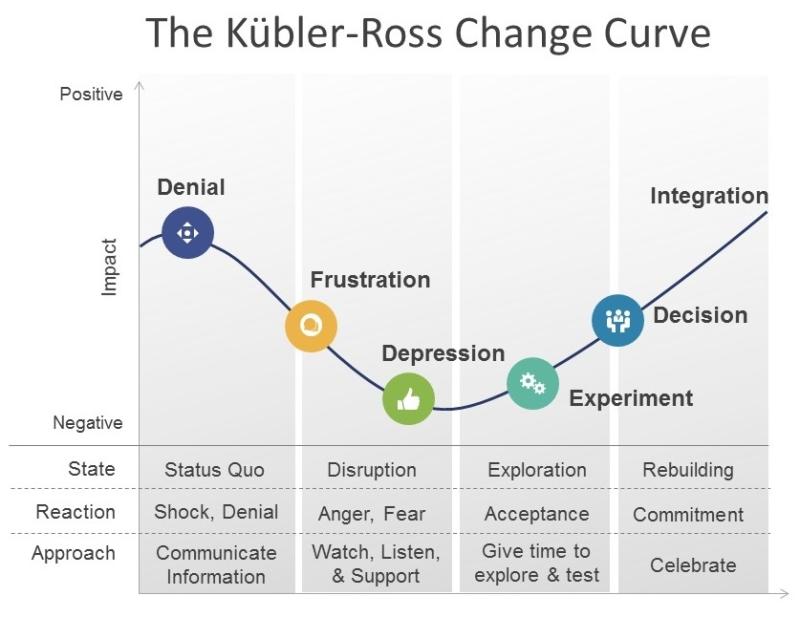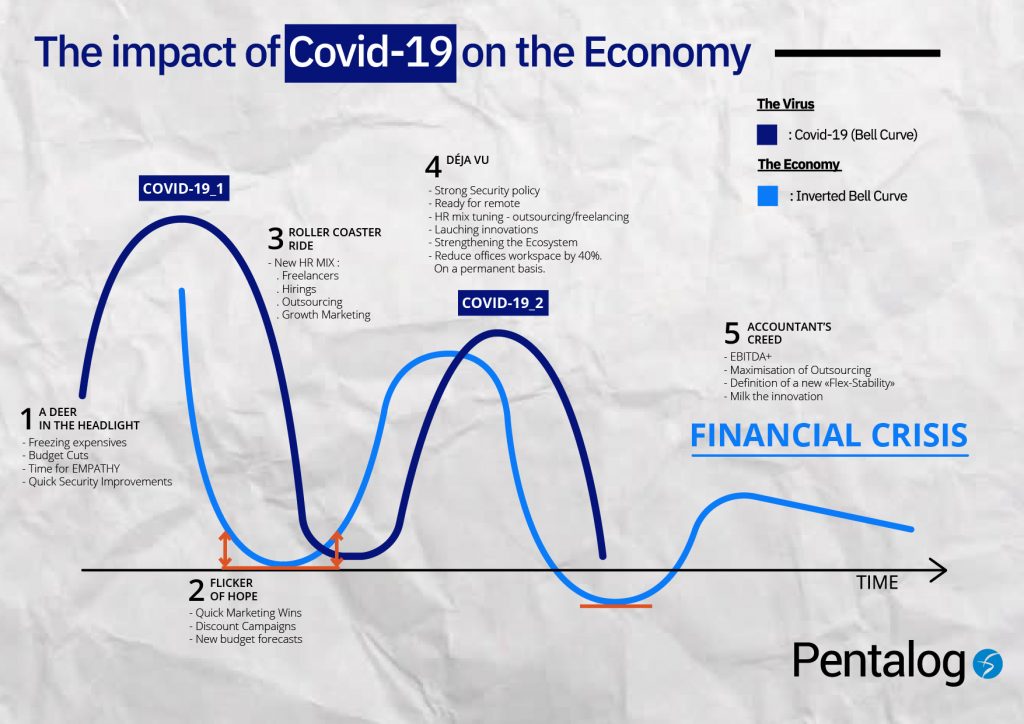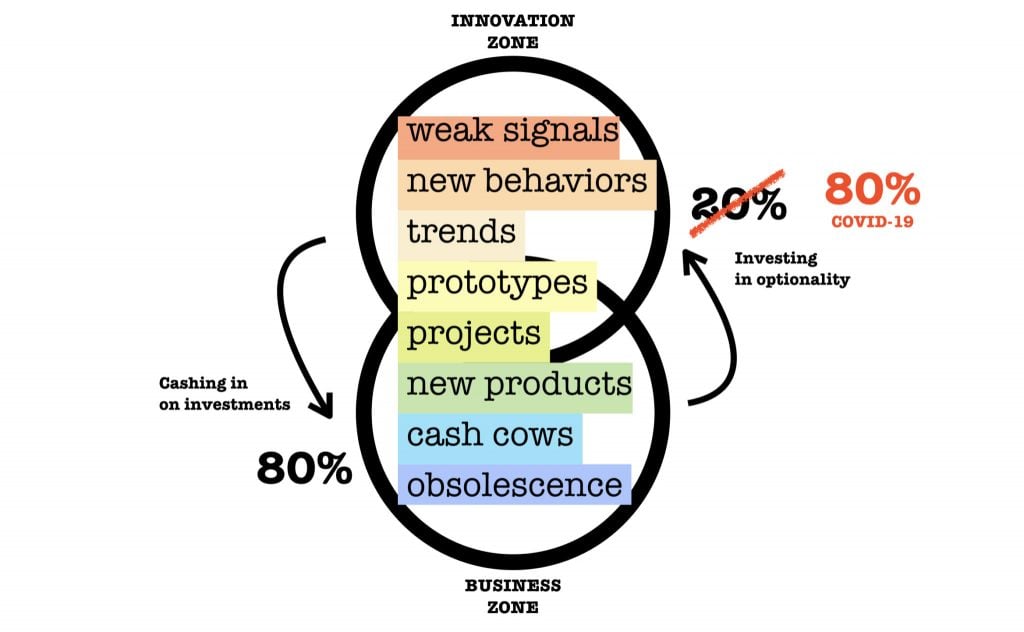COVID-19 and the IoT Industry: Analysis, Impacts, and Short-Term Actions to Compensate
The impact of COVID-19 on the world is marked and the IoT industry has not been immune.
The economic impacts are perhaps the most obvious but there are impacts on organizational behavior, workforce availability and hiring, working arrangements, social interactions, and corporate positioning that are undeniable, too.
In this article I intend to highlight the impacts that the COVID-19 pandemic has already had on the IoT industry and the likely impacts to come in the short-term. I also outline tangible actions that decision makers could take today in order to exit the crisis with confidence and position themselves and their companies to succeed in the post-COVID-19 world.
Part 1: Impacts on Business and Change Management
The Kübler-Ross Change Curve describes how any significant event or externality impacts a group. This change curve can be applied to the current COVID-19 crisis and the perceptions of business executives. In mid-March we were in a denial in the US and most of Europe – was this just a bad case of flu? Then came frustration of being “locked-up”, then we moved into the anger and depression phases of grief. We are now entering an experimental phase, and this phase will last for some time.

Source: masteringbusinessanalysis.com
The experiment phase is rather interesting as it will embed all the weak signals of future decisions that will shape companies and markets in the months and years to come. As we will see, the future might well be slightly different but the key for companies will either to be able to choose between creating it by exerting a high level of influence thanks to a certain critical mass and market footprint, or in the case of most companies choosing to surf this new wave.
3 Practical Steps You Can Take For Your Business
The overall idea is to Measure any weak signal coming from main stakeholders, customers, and partners in the coming weeks to begin collecting data points to help you understand the future shape of change ahead of your competitors
1 Organize a virtual roadshow with stakeholders, customers, and partners
- Prepare a mind map on the key areas of concern with regards to your business
- Host qualitative discussion based on current projects to gather insights
- Avoid direct questions but seek to understand the root causes of current trends
2 Investigate any business wins or losses, and reach out to your customers to understand
- The root causes of their decisions
- Any possible corporate mitigation plans they might have
- How and when you can expect to get back on track with them
3 Dedicate at least 20 minutes a day to a daily press review in order to zoom out of your own company situation and understand the macro effects of the crisis
You would then have to Try to connect data points to foresee the long-term decisions and the integration model you’ll need in order to steer your strategy accordingly and get ready to experiment with and to commit to existing customers; go with the flow of their acceptance of the crisis (Experiment, Decision, Integration) and maximize the odds of success along the way
Part 2: Impacts on Company Planning and Organization
Not knowing when and how the current crisis will evolve poses difficult questions for decision makers who do not have sufficiently solid information on which to base significant decisions, save for those that seek to avoid all risk. While a rebound is expected, the shape and style of that rebound is far from sure.
Economists talk of rebounds in terms of their shape. For example, a V-shaped rebound is marked and sharp with the economy quickly regaining the lost ground. A U-shaped rebound, on the other hand, is a rebound that is smoother and more gradual. These rebounds can be experienced differently at the national, regional, and global levels, with one country managing a fast V-shaped rebound while other economies are slower to respond to stimuli.
The Influence of a Global Economic Rebound
The expected V-shaped rebound is, unfortunately, increasingly unlikely to happen. Instead, things will take more time to be back to normal. A U-shaped rebound remains possible but there are worse scenarios to consider, too.

Source: Mc Kinsey & Company
Presently, experts seem optimistic, but the rebound may take longer to happen than expected and still wavers in the face of the threat of a second wave of the pandemic.

Source: Pentalog
The shape of the rebound will force a lot of businesses to put on hold many important decisions as they are deeply linked to the end date of the pandemic, something that remains unknown.
Timing the Way Out of the Pandemic Wave
Timing the end of the pandemic is almost impossible to predict:
- Well-coordinated action between countries adopting the same rules and fighting COVID-19 together is not happening
- The immunity of those that have already been infected is unknown, hence the push for herd immunity seems, presently, to be an unlikely strategy to be adopted by governments
It seems likely that pockets of COVID-19 infections will pop up again in different countries, thus sustaining the threat for months and even years.
The solution, then, is a vaccine or other therapeutic cure, with a vaccine the most likely as laboratories have known how to develop monoclonal antibodies for more than 20 years. Between research, trials, and approval, however, a vaccine is unlikely to arrive on the market in the next 18 months.
This situation clearly qualifies as a Black Swan event, a significant and unpredictable event with impacts that can’t be accurately forecasted. In a Black Swan event clear planning and forecast are hazardous, and the best way to prepare is to literally prepare the organizations for a variety of future scenarios.
4 Steps You Can Take to Move Forward
- Avoid a top-down planning model as it is too stiff to adapt quickly and efficiently in unpredictable times; instead switch to a more collaborative and agile organization
- Create regular sync rituals – remote or in person – to maintain motivation within your organization and to collect different points of views and be prepared to motivate your teams as you lead them
- Be transparent about the situation, including results, failures, and risks
- Adopt a scenario planning approach with pre-identified solutions
- Identify different scenarios from worst case to best case
- Stress test your models, including your business plan, your cash flow, and your production
- Identify weaknesses and imagine potential ‘patches’ for short-term issues, and solutions for longer term issues that could be implemented efficiently
An organization is always faster and more efficient when its real time improvisation and tactical shifts have been outlined in advance. In a way, it’s something like jazz: you may improvise on a theme, but all the structure has been carefully agreed on in advance with the other players.
Part 3: Impacts on New and Innovative IoT Device Projects
IoT Analytics completed conducted research on the potential impacts of COVID-19 on the IoT sector generally and on new and innovative device projects specifically. Via desk research and a series of interviews with IoT decision makers early in the crisis, they identified 25 different impacts of the pandemic on the industry, some positive and some negative.
Reviewing research like this and combining these conclusion with insights gathered from within and without Witekio, it seems clear to me that the primary impacts will fall into three main areas: competition between vendors, the organization of project teams, and the extent and number of new and innovative IoT projects in development.
Competition
Any organism attacked by an aggressor has a proportional reaction. This can be a reaction ranging from a strong and full defense that seeks to resist by protecting every part of the organism possible, or it could be a quick reaction to strike back.
It is very likely that we see such behaviors at the company level in the face of COVID-19.
The strong stimulus response caused by the financial stress of the COVID-19 pandemic will have an equally strong impact on technology providers and Original Equipment Manufacturers (OEMs) and may lead to significant changes in the market.
There are three primary criteria that will influence this:
- The free cashflow or available saved cash.
- Companies with low cash resources won’t have any other opportunity but to switch to a defensive posture, cutting investments and non-critical expenses to the minimum.
- Public companies that may allow themselves less bold moves than privately held companies
- Executives motivation to use the opportunity to take smart risks
Public companies may be held back by risk averse shareholders crisis and most of them will have formal action constraints in order to limit risk and loss of investments.
Privately held companies with an executive team that is willing to move forward may, in contrast, have an opportunity to take an advantage on their competition. It is a perfect period to take smart risks to definitely bet better than the competition.
There is a considerably strong decline in the demand for new projects and new devices presently and in the short term. However, in the mid-term, innovation will take on greater importance than ever before.

Source: Icopilots.com, April 2020
2 Actions You Can Take Today
For OEMs:
- Assess what moves can your company afford, negotiate an affordable loss, and move forward, and closely monitor any competitor shifts to gauge their strategy – will they freeze or invest in moving forward?
- If your company can afford it, now is the time to embrace cutting edge technology and bury competitors by innovating and moving forward while the others stay put
For Suppliers to OEMs:
- The sweet spot will be privately held companies with solid cashflow prior to the COVID-19 crisis
- Consider a switch to a consulting approach combined with a partnership approach, helping your prospects and customers to succeed in their bold attempts to continue investing in innovation through the crisis
The market dynamics will change permanently, redefining not only the competition but also the overall approach to the market.
Project Teams and Task Forces
Projects teams will be impacted at different levels:
- A large number of companies have already or will cut their non-essential budgets, often meaning cutting most of their subcontracting
- Team members may have been absent from the team for different reasons (lockdown, sick leave…)
- Accelerated remote work arrangements by under-prepared organizations
- Distractions in home offices due to closed schools and kindergartens
- General stress from the global pandemic with impacts on personal lives
All of these combine to result in less effective projects, movement outside of comfort zones, and oftentimes non-satisfying work situations for previously productive teams. This can impact on team coherence and motivation, and the most talented or impatient employees may be more tempted by other job opportunities than they were before. There is a real risk that teams themselves could be at risk.
The stop-and-go reality and the impacts of project freezes that arise in addition to the different impacts listed above can result in disorientation for the team. Remote managers have already had more difficulty motivating workers as they moved to a fully remote working situation so abruptly. The youngest generation of workers have long exhibited a need for meaning in their work, and there is a risk that they could be lost as the crisis bites business hard.
The risk aversion position adopted by a number of companies will have several impacts on the job market:
- Fewer job offers will be posted
- Staffing companies and freelancers will be on the bench for quite a while
- Some layoffs will continue, and these will become more common
All of this will lead to less pressure on the IoT job market for companies, likely driving salaries down and making hiring easier than pre-crisis times.
4 Ways You Can Seize This Opportunity
- Develop the why of your organization more than ever – having a vision and a strong corporate DNA will be a key success factor to retaining the best employees
- Switch to a more collaborative mode of working to actively involve more employees in decision making
- Take bold decisions about projects and stand behind these decisions in order to maintain your vision and drive teams forward transparently
- Launch a hiring campaign to take advantage of the opportunity of a flooded IoT job market, building up your development teams and hiring high performers
New and Innovative Projects
Let’s begin by stating the obvious: the vast majority of projects are delivered late when compared to initial go-to-market roadmaps.
All the impacts on teams described above have a strong impact on project organization and productivity, and this in turn implies a strong need for adjustments in delivery planning, feature roadmaps, and thus on internal expectations for all relevant teams.
Some companies will adopt a drastic approach, lay off all external task forces, and cut development budgets. This might be a good short-term tactic to save cash, yet the impacts on profit and loss in the mid-term will be significant. Such decisions, unless the company finds itself in a very poor cash situation, is not advised.
Adopting a compromise approach implies a demand to think differently. However, it is possible to maximize positive impacts in the mid-term while also taking the current situation into account by asking two questions:
- What is the minimum viable product that can be developed or released given the circumstances?
- What should be maintained and what could be cut down?
An Impact/Effort matrix can be used to initially respond to these questions. Adopting an agile methodology involving key internal stakeholders, partners, and customers in an incremental delivery process may be a good way to go to rationalize progress while getting the most out of the realistic possibilities.
More broadly, suppliers and customers should team up to pass through this phase of the crisis as, in the end, there is a common interest that projects continue to move forward.
The unpredictable aspects of the COVID-19 pandemic means rapid changes in project priorities for customers and partners alike. This means that the pre-sales process emerges as the first priority in the sales organization, with customer intimacy and a partnership approach recommended.
An evaluation of current product end-of-life or end-of-service timelines and what upcoming projects should be ‘must-haves’ is also very important. Some projects may be postponed but, at a certain point, they will need be to be renewed in one of two ways:
- If postponed for between one or two quarters: The focus should be on better planning upcoming projects and optimizing the future time to market. This should happen immediately as it is more cost efficient than undertaking the actual development and thus matching the cash constraint. It will have the benefit of maintaining the forward motion of the team while securing mid-term gains.
- If there is a more significant gap before the product launch: Check if software updates can be an alternative to a new product launch in order to maintain momentum and a good quality of service while avoiding redesigning a product or project from scratch.
Five Ways You Can Leverage This New Reality
- Focus on pre-sales efficiency and excellence
- Focus on workshops with partners and customers to redesign roadmaps, both in terms of features and planning – this could lead to new and different project opportunities
- Adopt a minimum valuable product approach and with a strong impact-to-effort bias in order to redefine product roadmaps
- If considering freezing projects, first analyze potential profit and loss impacts for the mid-term, then the actual cost of an MVP and lastly the current cash position.
- Organize workshops and training for your teams to lay the groundwork for a very efficient time to market development process when the immediate COVID-19 crisis passes
Conclusion
Getting through the COVID-19 crisis is one thing; emerging stronger and more resilient on the other side is quite another. The challenge for IoT corporate leaders is to take action today in order to position their business to succeed in the post-COVID-19 world, and the action steps in this article are examples of the sorts of strategies that can be adopted right now to exit the pandemic positioned to succeed.
Of course, there will be long-term impacts on the IoT sector that are beyond the scope of this article’s focus on the short to mid-term. What’s more, with national and regional governments still putting their economic stimulus plans together, there are likely to be additional opportunities and constraints that only emerge once those plans are announced. The key, though, is remaining agile, open to the change that has been forced upon us, and prepared to make decisions today to prepare for tomorrow.


